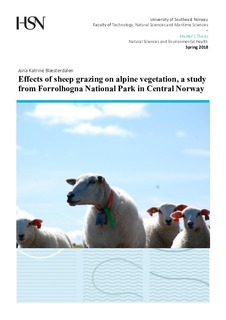| dc.contributor.author | Blæsterdalen, Aina Katrine | |
| dc.coverage.spatial | Forrolhogna National park, Norway | nb_NO |
| dc.date.accessioned | 2018-12-14T08:52:40Z | |
| dc.date.available | 2018-12-14T08:52:40Z | |
| dc.date.issued | 2018 | |
| dc.identifier.uri | http://hdl.handle.net/11250/2577674 | |
| dc.description.abstract | Alpine areas in Norway have a long history of domestic herbivory, and understanding the impact of grazing on alpine vegetation is therefore important for sustainable management of these areas. Domestic herbivory has the potential to modify alpine plant communities by establishing an equilibrium between the natural vegetation dynamics and the dynamics induced by the herbivores. A low to moderate grazing pressure can create a heterogenetic plant community through biomass removal, trampling results in open patches for plants to establish, and the release of nutrients through urine and feces, while high grazing pressure can lead to homogeneous plant communities, where the few grazing adapted species dominates. This study examines how alpine vegetation in two study sites in Forrolhogna National park in Central Norway is affected by grazing by domestic sheep. Ten study plots were analyzed, six of the plots had been fenced for the last 15 years to exclude sheep, while four were available for grazers. Data was collected in 2003, 2008 and 2017 in both grazed and ungrazed plots. The aim of this study was to test whether there are differences in species richness, –diversity and plant cover in grazed plots and plots that have not been grazed for 15 years, and how these plant responses is changed over time between 2003 and 2017. The cover of graminoids had decreased in ungrazed plots compared to grazed plots, and also decreased from 2003 to 2017. Other functional groups of vascular plants showed only small responses to the changed grazing regime caused by the absence of grazers. However, species richness had increased and the species diversity had decreased from 2003 to 2017 unaffected by the absence or presence of grazers. The grazing pressure in the study sites is relatively low, and the results of this study implies that the difference between low grazing pressure and no grazing is too weak to show extensive differences between grazed and ungrazed plots in 2017, after fifteen years of herbivore exclusion. The results suggest that other environmental factors might have greater impact than grazing on the vegetation of the study sites.
This study emphasizes the importance of long-term studies for understanding the processes of vegetation change and grazing by large herbivores, impacted by weather and climate. It provides a basis for further research in this study area, which may give valuable knowledge for the sustainable management in alpine areas in Norway | nb_NO |
| dc.language.iso | eng | nb_NO |
| dc.publisher | University of Southeast Norway | nb_NO |
| dc.subject | grazing | nb_NO |
| dc.subject | alpine ecology | nb_NO |
| dc.subject | alpine botany | nb_NO |
| dc.subject | vegetation | nb_NO |
| dc.subject | Forrolhogna National park | nb_NO |
| dc.title | Effects of sheep grazing on alpine vegetation, a study from Forrolhogna National Park in Central Norway | nb_NO |
| dc.type | Master thesis | nb_NO |
| dc.description.version | publishedVersion | nb_NO |
| dc.rights.holder | Copyright The Author | nb_NO |
| dc.subject.nsi | VDP::Matematikk og Naturvitenskap: 400::Zoologiske og botaniske fag: 480::Økologi: 488 | nb_NO |
| dc.subject.nsi | VDP::Matematikk og Naturvitenskap: 400::Zoologiske og botaniske fag: 480::Plantegeografi: 496 | nb_NO |
| dc.subject.nsi | VDP::Matematikk og Naturvitenskap: 400::Zoologiske og botaniske fag: 480 | nb_NO |
